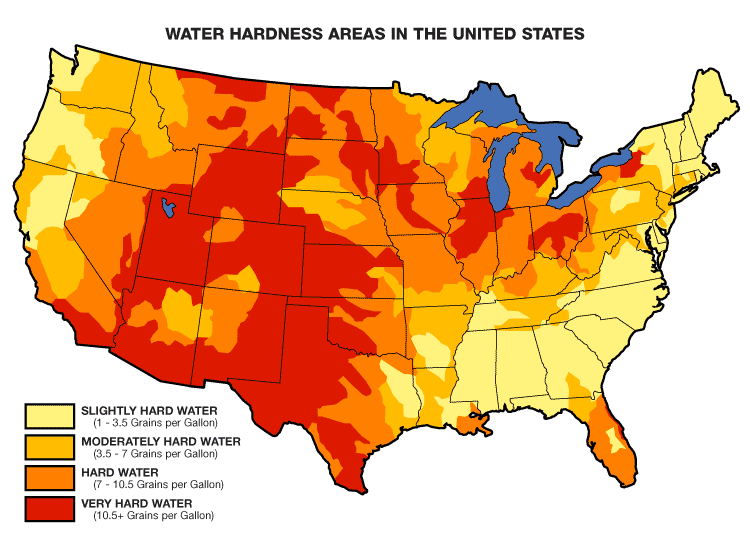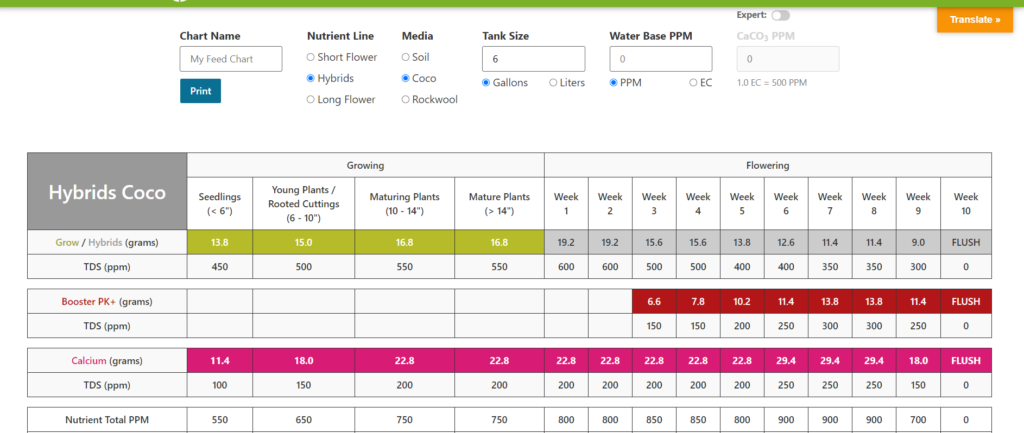After searching through the hundreds of products before finally selecting a high-quality hydroponic nutrient line, you may think the hard work is done. Not so fast — you still need to determine an accurate feeding schedule for your plants.
If the nutrient company has a feeding chart, then these are usually set up per gallon or liter, and you still need to calculate your own personalized chart based on the size of your reservoir, plant growth or bloom stage, and water hardness. That’s a lot of work, and it’s really easy to make a mistake if you’re not careful. Super careful. This is tedious and unnecessary now!
To make this process easier for you, we created the absolute best hydroponic nutrient solution calculator on the planet for Green House Feeding nutrients Mineral Line. The best and most soluble hydroponic nutrient available today.
While you can follow a basic feed chart, you’ll still need to adjust the recommendations based on your specific growing conditions. A nutrient calculator does the work for you, allowing you to supply your plants exactlythe nutrients they need. That means happy plants, high yields, and no more wasted nutrients.
We’re going to cover the basics of feed charts and nutrient calculators and let in you on a little secret…not all calculators are the same.
Why Use a Feed Chart?
After you’ve selected a nutrient line, you need to make sure you supply your plants with the proper amount of nutrients. You can’t just add 5 grams of fertilizer every week and expect your plants to flourish! No, you’ll need to tailor your nutrient inputs to your plants’ needs.
Remember that plants require different amounts of nutrients as they grow. It might be obvious that larger plants need more nutrients than smaller plants, but feed charts let you know just how much more to supply at week 1 vs week 3 of vegetative growth.
Another thing that feed charts help with is applying nutrients during the vegetative and flowering stages. In case you didn’t know, plants’ nutrient needs change as they switch from veg to flowering. As flowering begins, plants need more potassium, calcium, and phosphorus. Feed charts help you phase out and add in different products so you can meet your plant’s nutrient needs.
If you apply the same amount of nutrients throughout your plants’ lives, you’ll end up with either nutrient toxicities or deficiencies. Plus, you’ll be throwing nutrients (and money) down the drain.
The Limitations of Using a Chart to Determine a Hydroponic Feeding Schedule
Typically, each nutrient brand will supply feed charts for these individual products. But, these charts have their limitations. Many charts only provide basic info such as the amount of each nutrient you’ll need to add per gallon of solution each week.
You may be thinking “what about media, doesn’t that matter? Or how about the number of weeks a plant is in the vegetative stage?” And you’re right!
Since these charts don’t account for variables between hydroponic systems, they don’t provide exactly the nutrients a plant needs. Sure, they’ll get you close. But why settle for mediocracy when you can achieve excellence?
What is a Hydroponics Nutrient Calculator?
While nutrient calculators are similar to feed charts, they provide you with a more precise picture of the nutrients you’ll need to add to your hydroponic system. Just like all calculators, you enter in the information you have and receive an answer in return. But with these calculators, it’s a lot more than 2+2=4.
When using a nutrient calculator, you’ll enter information about your hydroponic system such as the size of your stock tank, the type of nutrient you are using, and the base PPM or EC of your solution. All you have to do is hit enter, and the calculator will provide you with a feeding chart that shows you how much of each nutrient product to add each week.
Understanding the Components of a Nutrient Calculator
Now that you know what feeding charts and nutrient calculators are, let’s dive into some of the components and details of a calculator. While not all calculators will include the following elements, the good ones will.
Base PPM or EC
When it comes time to calculate how many nutrients to add to the solution, you’ll want to know if any minerals are already in your water. To do so, you can measure the parts per million (ppm) or electronic conductivity (EC) of your solution. The ppm tells you how many minerals are in solution, while the EC measures the number of salts in solution.

If you are starting with a PPM or EC higher than 0, you’re already starting with some minerals in your water! This is often the case when water contains calcium, aka it is hard water. If your water is hard, you won’t have to add as much calcium, since some of this mineral is already in solution.
If a calculator doesn’t account for base PPM or EC, you could be adding excess calcium to your solution.
Type of Media
Different types of media react to nutrients in different ways. For starters, soil typically contains residual nutrients while inert media like coco and rockwool don’t contain any nutrients.
There are also differences in the cation exchange capacity (CEC) of each material. That means some materials hold onto nutrients more than others, affecting how many nutrients you need to apply over time.
If a calculator provides the same feeding chart for all types of media, it’s falling short. And that means your plants are unlikely to live up to their full potential.
Nutrient Product(s)
Since different hydroponic fertilizer products contain different amounts and ratios of nutrients, the application recommendations will vary between products. Additionally, you might be using more than one product at a time. A good nutrient calculator will tell you how much of each product to add during each week of a plant’s growth.
The Green House Feeding Nutrient Calculator

The Green House Feeding Nutrient Calculator
Like we’ve said, each nutrient line should have its own feeding chart or nutrient calculator. If you’ve selected the Green House Feeding line of nutrients for your hydroponic system, you’re in luck! The nutrient calculator for this line of products takes into account details like your tank size and media type to provide you with an accurate feeding chart. That means there’s no guessing on how you should alter a chart to account for different types of media or a high base ppm.
Using the calculator is easy. All you have to do is enter in the nutrient line (long-flower, short-flower, or hybrid), media type, tank size, and base water ppm. Simply hit enter and you’ll receive a feeding chart that tells you how many grams of each product to add to your solution tank.
Looking at the Competitors
If you take a look at competitors like the Advanced Nutrients Nutrient Calculator and General Hydroponics Nutrient Calculator, you’ll notice they are super basic! Making the best nutrient calculator isn’t easy. They’re missing key components like the type of media! And they don’t adjust for calcium or hard water, and they don’t print as nicely as the Green House Feeding Nutrient Calculator does.
While it would be great if nutrients behaved the same in coco coir as they do in soil, this isn’t the case. And that means you can’t expect to be able to apply the same amount of nutrients to plants grown in different types of media.
Get Calculating
With a tool like the Green House Feeding Nutrient Calculator, it’s as easy as 1-2-3 to calculate the amount of nutrients your plants need. And since this calculator accounts for all the variables that would affect nutrients, you don’t have to worry about trusting the numbers it provides.
References
Mineral Nutrient Deficiencies and Toxicities
A Recipe for Hydroponic Success
Hard Water Hardness Calcium Magnesium Water Corrosion Mineral Scale

Where do I get the GHF Calculator?
What products do I need to buy to get started?
Hi Victoria,
If you click the “hydroponics nutrient solution calculator” underlined link in the 3rd paragraph of this article, it will take you directly to the GHF calculator. You can also click on this link: https://www.globalgarden.co/calculators/ghf-nutrient-calculator/
As for what products you need to get started, the calculator will certainly be able to help you with that. However, if you have any questions at all, please email us at [email protected] and one of our product experts will get back to you ASAP! We would love to help you out with this!